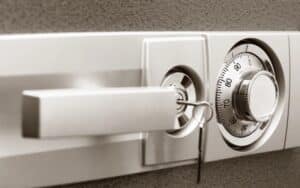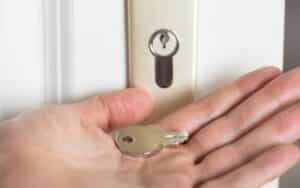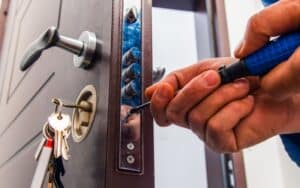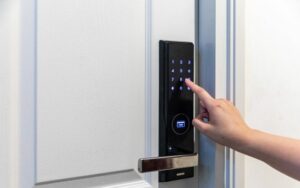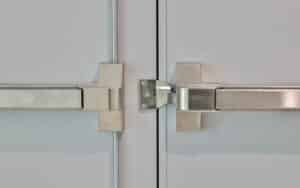Ever found yourself staring at a safe, the key nowhere to be found or the combination a distant memory? You’re not alone. Safes are the guardians of our most precious items, yet the inconvenience of lost access can be a major headache.
Don’t fret, though; there are ways to regain entry without resorting to a sledgehammer. Whether it’s an electronic, biometric, or a more traditional safe, understanding the right non-destructive techniques is crucial to unlock your valuables without damage.
Table of Contents
ToggleUnderstanding the Basics
What is a Safe?
A safe is a secure lockable box designed for protecting your valuable items from theft, damage, or loss. Built with robust materials like hardened steel, safes are engineered to withstand physical attacks, fire, and water damage. They serve not only to secure precious possessions such as jewelry and important documents but also to safeguard sensitive information and firearms. The security a safe provides is not just physical but also psychological, giving you peace of mind.
The construction of a safe includes features like thick walls and doors, complex locking mechanisms, and sometimes advanced technologies such as biometric scanners. The level of security offered by a safe is often rated by industry standards, with ratings like UL (Underwriters Laboratories) and BSI (British Standards Institution) indicating the degree to which safes can resist external attacks.
Different Types of Safes
Safes come in various forms, each designed for specific purposes and levels of security. Here are the most common types:
- Electronic Safes: These use an electronic keypad where you input a digital code for access. They often have backup keys or override systems for emergency access.
- Combination Safes: Operate with a mechanical dial or electronic keypad where a sequence of numbers unlocks the mechanism.
- Key-Operated Safes: The traditional method requires a physical key to unlock. While simpler, these can pose a risk if keys are lost or stolen.
- Biometric Safes: Use personal characteristics like fingerprints or retinal scans for authentication, offering quick access and heightened security.
- Wall Safes: Installed within walls; these provide concealment for valuables and typically have a flush mount to hide their presence effectively.
- Floor Safes: Embedded in concrete floors, they’re hard to remove and offer excellent protection against burglars.
- Fireproof and Waterproof Safes: These are specifically engineered to protect against fire or water damage, with ratings to indicate the duration of protection under extreme conditions.
Each type has its own set of security features and potential vulnerabilities, and the choice depends on the level of security you require and what you’re aiming to protect. It’s crucial to assess your needs and consider factors like size, location, type of valuables, and the safe’s resistance capabilities when making a choice. Remember, higher security often comes with a higher price tag, but the investment is justified when it comes to safeguarding one’s most priceless possessions.

Gathering the Necessary Tools
Safe Opener Tools
To tackle the challenge of opening a safe, you’ll need an arsenal of specialist safe opener tools. A borescope is indispensable for non-destructive insight. This slender, flexible camera snakes into the safe, giving you a visual on the internal mechanisms, specifically tumblers, to deduce the combination without drilling or cutting. Pair this with a dial indicator which meticulously measures resistance as you turn the dial, eliminating guesswork in decoding the lock combination. This tool records both the number of turns and the resistance, guiding you to the precise combination.
Another critical item is a lock pick set tailored for safes. This advanced tool requires skill but can successfully manipulate strong bolts to grant access without the original key or combination. For electronic safes, a reset button tool, such as a simple paperclip, could reset the code, though this represents a vulnerability rather than a feature of secure safes.
Remember, safe opening without damage is an intricate task demanding not just brute force but finesse and a deep understanding of safe mechanics.
Additional Tools
While safe opener tools are pivotal, sometimes more aggressive measures are necessary. In such cases, an electric drill with a variety of bit sizes becomes the tool of choice. Start small and increase the bit size gradually until you breach the locking mechanism to operate the lock with a tool like a flathead screwdriver.
In the case of a dial that won’t budge, a crowbar can be employed to pry the door, particularly if the door is thinner and less resistant. A dose of lubricant on the hinges can simplify this task, but be warned, this method compromises your safe’s integrity.
If you are confronted with a safe that includes a digital lock, ensure you have safe cracking software that might exploit weaknesses in the electronic system. This approach should only be undertaken by professionals with an in-depth understanding of digital security systems to avoid permanent lockout or damage to the electronic components. Keep in mind that while you’re collecting these tools, you are stepping into a complex field that typically requires a locksmith’s precision and expertise.
Assessing the Safe
When you’re faced with a safe that needs opening, proper assessment is crucial. You’ll first need to conduct a thorough evaluation to determine the best course of action.
Visual Inspection
To begin with, a visual inspection is essential. Here’s what you’ll want to look for:
- Check for any visible damage or tampering. Signs of wear could indicate a compromised structure which might make the safe easier to open.
- Identify the safe type; is it a manual-dial or an electronic keypad? This knowledge is key as it dictates the tools and methods required.
- Look for a manufacturer’s label or model number. Having this information can guide you to specific techniques known to work on that particular safe.
- Bolted safes require different approaches than portable ones. If the safe is anchored, it won’t be possible to remove it from the premises easily.
Listening for Clicks
Next, you’ll turn to auditory cues, specifically listening for clicks emanating from the locking mechanism as you manipulate it:
- Use a high-quality stethoscope to discern the sound of the tumblers aligning. The correct equipment is vital for this delicate process.
- With a manual-dial safe, begin slowly rotating the dial, listening intently for the distinct clicks of the lock engaging. – Be aware of ambient noise; you’ll need a quiet environment to hear the click of the tumblers correctly.
- Document the numbers that correspond with these sounds; they’re likely part of the safe’s combination.
Remember, safes are engineered to protect treasures behind their doors. Expert thieves know this, so they’d often focus on these tips to identify the combination. Your success hinges on patience, a keen ear, and attention to the slightest auditory signals.
Trying Common Methods
Brute Force Method
Brute force is one of the straightforward ways you might consider to open a safe. This doesn’t require a deep understanding of the locking mechanism and seems like a quick fix. But, it’s often not without consequences. The brute force method includes:
- Prying: Using tools like crowbars to force the door open which might seem effective for safes with thinner doors, but often leaves irreparable damage.
- Cutting: Using saws or torches to cut through the safe material, but you’ll risk damaging the contents inside.
- Drilling: Though seen as a last resort, drilling is a method used to bore a hole into the safe to bypass the lock. It’s a method professionals use, applying various drill bit sizes and specific techniques tailored to the lock type.
Remember, these methods are destructive and typically used when other non-damaging methods have failed. If you’re not trained in safe cracking, brute force can lead to costly damages not just to the safe but potentially what’s inside it.
Dial Manipulation Method
Dial manipulation is a non-destructive technique that preserves the integrity of the safe. It requires precision, patience, and a keen auditory sense. Here are the key points to consider when using the dial manipulation method:
- Sound Cues: Position your ear close to the safe or use a high-quality stethoscope to listen for clicks or beeps when the tumblers align.
| Tumbler | Sound Cue | |———|———–| | Aligned | Click | | Misaligned | No click |
- Dialing Technique: You’ll need to follow a precise dialing pattern. It’s important to make no errors in the sequence, and if a mistake is made, start over.
| Dialing Sequence | Requirement | |——————|————–| | 4 times right | Stop at number | | 3 times left | Stop at number | | 2 times right | Stop at number | | 1 time left | To open |
- Accuracy: When dialing, your margin for error is minimal – typically plus or minus half a space to the next mark on older locks and even less on newer models.
In the case of older safes, taps or slight jiggles might assist in loosening stiff mechanisms, but these must be done with caution. Always avoid force that may cause internal damage and know that modern locks seldom forgive such tactics. If attempting the dial manipulation method, you’re advised against hurrying the process; slow and steady adjustments can make all the difference between successfully opening the safe and having to restart the sequence.
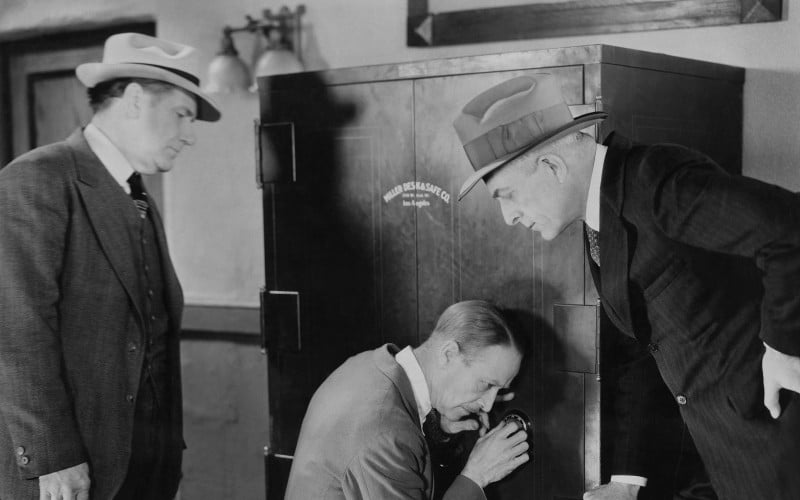
Advanced Techniques
When you’re faced with a safe that won’t budge, and traditional methods have failed, it’s time to consider advanced techniques. These procedures are more intricate and should only be tackled if you’re well-versed in safe mechanics or by enlisting a professional.
Bypassing the Lock Mechanism
To bypass the lock mechanism, you must understand the intricate workings of your safe. Safe manufacturers often include an emergency key override for instances when you forget the combination. Using a mechanical key override is a direct way to bypass the lock if the key is available. But, this mechanism adds vulnerability as anyone with the key can bypass the combination. In some instances, locksmiths maintain a collection of emergency keys, making it possible to access the safe without the combination.
Another advanced technique involves lock picking, which, while complex, is an alternative if you possess the skill set. Keep in mind that the bolts in safes are designed to be tamper-resistant, hence lock picking is not a simple feat. Only with special tools and expertise should you attempt to pick the lock on a safe, bearing in mind that this might compromise the integrity of the security device.
Drilling the Safe
Drilling into a safe is a delicate process that requires knowledge of the safe’s internal components. You’re either creating an entry point for a borescope to manipulate the dial or to reach the lock’s actuator directly.
Precise location and appropriate tools are mandatory for this method to avoid damage to the safe’s contents or the safe itself. Professional locksmiths often resort to this method as a last measure. They use specialized drill bits designed to penetrate hardened materials and steel plates without breaking off, indicating the level of sophistication required for such an operation.
When drilling, any evidence of the intervention could render the safe more vulnerable in subsequent uses. In cases where a safe has a relocker, which is a security feature that engages when the safe is under attack, drilling is almost the only option. The relocker must be drilled carefully, which necessitates technical knowledge of the specific safe model and an understanding of its protective features.
Seeking Professional Help
When you’re unable to access your safe, reaching out to a professional locksmith is often your best option. They come equipped with the necessary tools and expertise to handle the situation without causing damage to your property. Licensed and insured, a reputable locksmith will ensure that your assets are protected during the process. Locksmiths are trained to work with a wide range of locking mechanisms, including those in your safe. They possess specialized tools that are designed specifically for safe opening without resorting to destructive methods. Good locksmiths offer a high level of service that includes not just opening the safe but also repairing any potential issues, ensuring future functionality. Your privacy is maintained, and the security of your safe’s contents is upheld.


